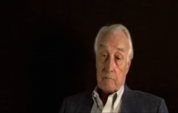3:57 | Casey Westell vividly describes top secret documents from 1944 that a friend reproduced. He displays his awards, photos and memorabilia from the era.

Casey Westell explains why he was told he couldn't be a World War II pilot and how he ended up with a much more dangerous job.
In this vivid account, Casey Westell describes the plane he was assigned to and the gun turrets he was expected to operate while searching for German submarines.
In 1945, while bracing to be dispatched to patrol the seas near Japan, Casey Westell 's orders suddenly changed. He now reflects back on the strategic plan that changed the course of history.
After serving on shore patrol, Casey Westell reflects back on how his life changed at war's end and the journey he took to further his education.
Casey Westell explains how an illness prevented his untimely death in the skies, and demonstrates why the plane he wound up on was the safest in the air.
Casey Westell vividly describes top secret documents from 1944 that a friend reproduced. He displays his awards, photos and memorabilia from the era.
While delivering supplies to the French and English during their fight against the Germans, Casey Westell relives night patrols searching for and finding enemy subs. Here he describes why his ship was told not to attack.
At eighteen years old, fighting the Germans seemed like a dangerous adventure to Casey Westell. Today, he describes why he was so grateful for the experience and to the U.S. government.
A trip to a Texas air museum sparks Casey Westell's memory. He describes what it was like to be a gunner on a WWII plane and an unusual story of how two Germans were captured.